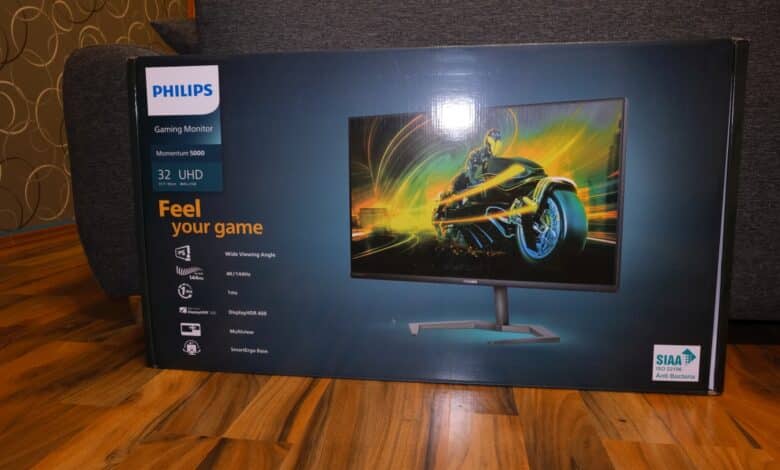
In March 2022, Philips introduced the new M5000 series of monitors, which should appeal to gaming fans in particular. This should be continuously expanded over the course of the year. For example, it includes an exciting gaming monitor with 4K resolution, modern features and a refresh rate of 144 hertz, which we took a closer look at for the Philips 32M1N5800A review.
Technical data
| Display Size | 32 inch / 80cm |
| Resolution | 4K UHD (3840 x 2,160 pixels) |
| Screen refresh rate | 144 Hz |
| Panel type | IPS / W-LED |
| Screen Surface | Non-glare |
| Image format | 16:9 |
| Brightness | 500 cd/m² |
| Contrast ratio | 1,000:1 |
| Screen colors | 1.07 billion |
| Color space | 124 % sRGB 87 % AdobeRGB 113% NTSC |
| Viewing angle | H: 178° / V: 178° |
| Curvature | none |
| Response time | 1 ms (GtG) |
| Connectors | 2x DP 1.4 2x HDMI 2.1 4 x USB 3.2 Gen 1 |
| Audio | 1x audio out (3.5mm jack) |
| Integrated speakers | yes (2x 5 watts) |
| Color | Black |
| Dimension (without stand) | 715 x 420 x 60 mm |
| Dimension (with stand) | 715 x 640 x 297 mm |
| VESA suspension | 100 x 100 mm |
| Weight (product/total) | 7.74 / 10.55 kg |
| Energy consumption | 64.0 W |
| Standby consumption | ≤ 0.5 W |
| Energy efficiency class | G |
| Special Features | DisplayHDR 400; AMD FreeSync Premium; G-Sync compatible; LowBlue mode; SmartImage HDR |
| Price | € 696.84 * |
Philips 32M1N5800A review: the scope of delivery
The Philips 32M1N5800A reaches us in a large, blue-black box, which presents the individual components securely packed. The scope of delivery presents itself as you are used to from most monitors.
Besides the display itself, the stand comes in two parts. Besides the usual instructions, notes and warranty cards, the manufacturer also includes a whole range of ultra-modern cables. Besides a high-speed HDMI cable (8K), a DisplayPort cable, a USB upstream cable, and the corresponding power cord round out the scope of delivery.
Assembly and startup
The assembly of the Philips 32M1N5800A is quite simple and does not even require reading the instructions. Because the assembly of the monitor is done completely without tools.
First, you should place the display on a flat, soft surface and insert the upper part of the stand using the quick-release connector on the bracket provided at the back. Below that is also the VESA mount with a 100 x 100 mm hole, in case you want to place the monitor on a wall or monitor arm.
Now only the lower part of the stand needs to be inserted into the corresponding opening and screwed in place. That’s it. It really couldn’t be easier or faster.
Design and workmanship
- Very heavy weight; rugged construction
- High-quality workmanship
- Antibacterial surface
Directly during assembly, it is noticeable how comparatively robust and bulky the stand alone turns out to be. Both parts of the stand weigh 2.81 kilograms in combination, and the Philips 32M1N5800A weighs 10.55 kilograms in total.
That is still one and a half kilograms more than, for example, an LC-Power LC-M34-UWQHD-100-C-V3 (our review), which comes with a significantly larger 34-inch ultrawide panel.
The fact that the Philips monitor plays in a different league here becomes apparent when looking at the build quality, which does not give any reason for criticism. The display is robust, and you won’t find any gaps or inconsistencies. Chapeau, Philips.
As far as the general design of the 32M1N5800A is concerned, there aren’t any special features worth mentioning. It is just a fairly normal, comparatively dignified monitor with a flat IPS panel. Without RGB lighting or special elements.
Of course, this does not mean that the display is an ugly duckling. With the silver base and anodized finish, the two-tone design at the back, and the back covered with many small squares, the monitor certainly looks the part. Without being out of place.
The only control element in the form of a square joystick is found in the lower right corner on the back of the monitor. It is used to turn the display on and off, as well as to navigate through the OSD menu.
You’ll find the ports on the bottom, with a type designation on the back informing you about the placement of the respective ports. With black lettering on a black background, which doesn’t necessarily help readability in poor lighting, but oh well.
However, there are three special features. On the one hand, the stand has a cable holder on the bottom, which is hardly worth mentioning, though. On the upper side, you can attach a monitor holder. This is made of plastic and doesn’t look particularly robust. It also sits very loosely on the stand. But at least it’s a nice-to-have.
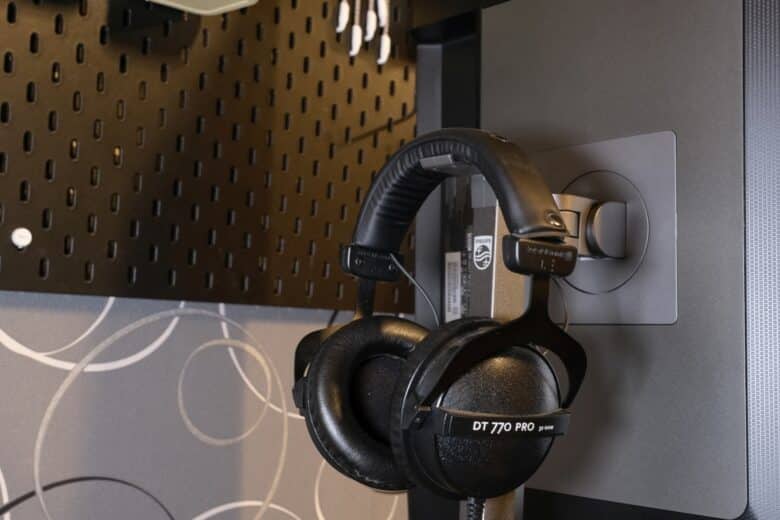
The manufacturer calls the third special feature “SIAA-certified antibacterial treatment for hygienic surfaces”. According to this, antibacterial agents with ionic silver treatment are supposed to inhibit bacterial growth on the monitor’s surface and thus keep the surface clean. Sounds good, but we can’t verify it. We’ll just take Philips’ word for it that the display won’t give the unloved creatures a foothold.
Connections, equipment and controls
- Convincing selection of connections
- 2x HDMI 2.1
- Comfortable operation via joystick
In terms of the modern selection of connections, the Philips 32M1N5800A actually leaves nothing to be desired. In addition to two DisplayPort 1.4 ports, you have a whole two HDMI 2.1 ports at your disposal, which should especially please owners of current consoles such as PlayStation 5 and Xbox Series X – because both are capable of playing back 4K at 120 fps including VRR (Variable Refreh Rate).
In addition to a 3.5 mm jack, there are four USB-A ports. Two of them come with a blue color scheme, and two others are yellow. The latter have BC 1.2 Fast Charging. A USB-B uplink port rounds off the port selection.
Too bad: Unfortunately, Philips consistently omits USB Type-C or a KVM switch, which would have been quite possible considering the price.
Philips also integrates two 5-watt speakers, but they are hardly worth mentioning. The sound is quite muffled and not very detailed. Just as you would expect from monitor speakers. Quite nice for in between, but real speakers can’t replace them.

As for the controls, as mentioned, only the four-way joystick on the back is available. Pressing it turns the display on, and you have to hold it down longer to turn it off. Otherwise, you navigate through the on-screen display with it.
Features and ergonomics
- DisplayHDR 400 certification
- MultiView and SmartImage HDR
- Extensive ergonomics options
Looking at the specifications, Philips makes it unmistakably clear that they are primarily targeting demanding gamers with the 32M1N5800A. At least as far as possible.
With a 4K UHD resolution (3,840 x 2,160 pixels), a refresh rate of 144 hertz and a response time of one millisecond when switching from gray to gray, the 5000-series monitor is very well positioned in any case.
The matte IPS panel has a W-LED backlight and achieves a maximum brightness of 500 cd/m² (according to the manufacturer), which earns it a DisplayHDR 400 certification. However, this also makes it clear that the Philips 32M1N5800A does not offer true HDR.
AMD FreeSync Premium is also offered for a smooth gaming experience, while the monitor is also classified as Nvidia G-Sync compatible. A particularly low input lag or latency and a SmartImage HDR mode (or several modes) are also promised, which is supposed to optimize the picture especially for games, movies or photos.
Further plus points: MultiView allows the simultaneous display of two connected devices for multitasking, while the Ultra Wide Color technology should also make the monitor interesting for professional users. However, all this has to be proven in the display test first.
In any case, the ergonomics leave nothing to be desired. You can adjust the height of the display by 130 mm, tilt it between -5 degrees and +20 degrees, rotate it between -45 degrees and +45 degrees, and even move it 90 degrees vertically thanks to the pivot function. All this is also done very comfortably thanks to the high-quality and smooth-running stand.
Picture quality of the Philips 32M1N5800A in review
But what about the promised picture quality of the Philips 32M1N5800A in the test? We naturally put it through its paces with the help of the Datacolor SpyderX Elite measuring device, among other things, as well as in a practical test and other trial runs.
First of all, the note: Our test model is, especially in the lower area, relatively strongly affected by backlight bleeding. Furthermore, several dead pixels show up in the center. However, this can always happen with monitors. We received a replacement model from the manufacturer. Even as an end customer, an exchange is possible without any problems, so these problems are not included in our rating.
In practice, the monitor scores with a convincing brightness, rich colors and very good black levels, although I personally find the color intensity too saturated in various SmartImage modes. On the other hand, sharpness needs a bit of fine-tuning – but you can easily adjust both via the OSD and improve the image significantly.
Lab test
- Average factory calibration
- Very good color space coverage
- Convincing brightness, good contrast values
The lab test of the Philips 32M1N5800A shows a very good picture overall. Only in terms of color fidelity can the gaming monitor not meet the manufacturer’s specifications with an average value of DeltaE 4.11, although you can also remedy this with the help of a calibration and thus come to a value of Delta E <1 – an outstanding value!
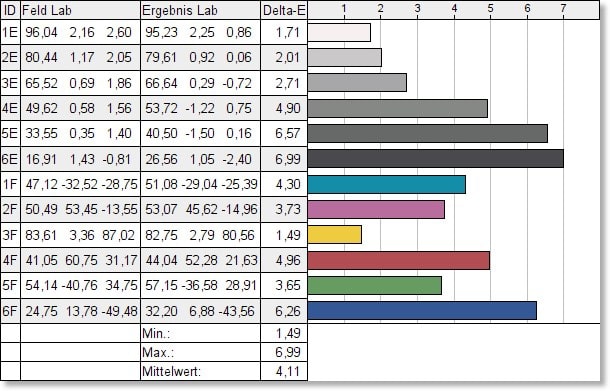
However, the manufacturer-side calibration offers room for improvement. Whereby it has to be said: DeltaE 4.11 is by no means a bad value. You are still pretty far ahead with that. However, you should do it yourself to improve the picture quality.
On the other hand, there is hardly anything to complain about in terms of color gamut. 100 percent sRGB, 85 percent AdobeRGB and 91 percent DCI-P3 are recorded in the test. Good values.

The 32M1N5800A also scores in terms of tonal range, with a near-perfect calibration at all five settings between gamma 1.8 and 2.6, where the default value at gamma 2.2 serves as our guide. However, the curve aligns perfectly with the default in all settings.

The brightness and contrast ratio continue in a similarly positive vein. At full 100 percent, the Philips monitor achieves a whopping 565.7 cd/m², a higher value than promised by the manufacturer, and also clearly exceeds the manufacturer’s specifications in terms of the contrast ratio of 1370:1. There’s not much to complain about in terms of the white point either. 6700K – 7000K are by no means too warm or too cold.
However, slight problems reveal themselves in the monitor’s color and luminance homogeneity. Especially the upper right corner seems to be somewhat problematic. At full brightness, there is a color deviation of DeltaE 48 here – but all values are still in the very good range.
In terms of luminance homogeneity, i.e. the uniformity of the illumination, the rectangle on the upper right is the best matched and achieves 0 percent. There are clear deviations in the lower left rectangle, which, however, become lower and lower with increasing brightness and are already in a good range from 83 percent.
At 100 percent brightness, we are still at a value of 520.9 cd/m² here and thus above what the monitor should actually achieve. So it fits. The Philips 32M1N5800A test shows a coherent overall picture. You can further optimize the color calibration by hand and thus further improve the picture quality.
Practical and Gaming Test
- Detailed, sharp image
- Low response time
- Nearly no ghosting
Apart from the, ex-factory, somewhat too saturated colors, the 32M1N5800A does exceptionally well in the practical test. With a little fine-tuning, the monitor presents itself with a sharp, detailed 4K picture that scores in everyday office use, media consumption and gaming.
The comparatively low response time and the minimal input lag are positive for gamers. There are several response time modes to choose from, which surprisingly come along without strong ghosting even in the highest setting (“fastest”).
Thus, there is little to complain about in terms of picture quality. However, a DisplayHDR 400 certification is not real HDR. And those who buy the monitor for use with the current consoles might be a bit disappointed, since local dimming zones are conspicuous by their absence.
On the other hand, you have to put this in perspective, because other 32-inch monitors with 4K resolution in this price segment rarely offer more and come with HDR 600 certification at most. If you want more, you either have to dig a bit deeper into your pocket or give up a few centimeters in the screen diagonal.
OSD settings
The Philips 32M1N5800A’s on-screen display offers you plenty of setting options in a clearly structured and understandable menu. However, you can only adjust most of the picture settings if you deactivate HDR in the Windows display options. Otherwise, the monitor’s SmartImage takes care of the options for you.
For example, you can activate Adaptive Sync, add the overdrive mode (SmartResponse) or set the refresh rate of the individual inputs separately. Various SmartImage modes are also available, as well as the obligatory options for adjusting brightness, contrast and sharpness.
Various quick commands are also possible via the joystick. If you move it upwards, you can quickly switch between the different inputs or make quick image adjustments to the left. In general, I find the operating concept quite successful. Only holding down the joystick to turn off the monitor takes a bit of getting used to.
Philips 32M1N5800A review: conclusion
In the Philips 32M1N5800A test, the 4K gaming monitor presents itself as absolutely well-rounded and actually does not offer much cause for criticism. The manufacturer opted for a simple, somewhat boring design, which is combined with a very high build quality and a sturdy stand.
The selection of ports is just as pleasing as the display’s general performance, although the factory calibration should be better. The only points of criticism are the lack of a true HDR image and a few additional features like USB-C or a KVM switch.
In return, the Philips monitor positions itself with an aggressive price compared to similar models, such as the similarly positioned Corsair XENEON 32UHD144, which offers HDR 600 and USB-C, but also costs around 300 euros more.
If you’re looking for a great 4K monitor for high-end PC gaming or current consoles and don’t care much about HDR, the Philips 32M1N5800A is definitely worth a look.
Philips 32M1N5800A
Workmanship
Image quality
Features
Value for money
93/100
High-quality and all-around convincing 4K gaming monitor with excellent port selection, responsive display and convincing picture quality for an absolutely fair price.







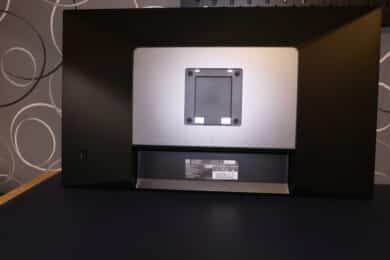
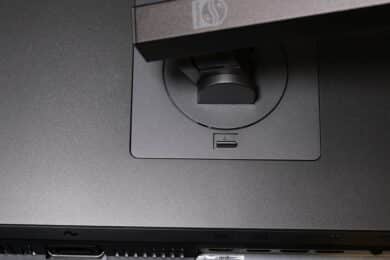
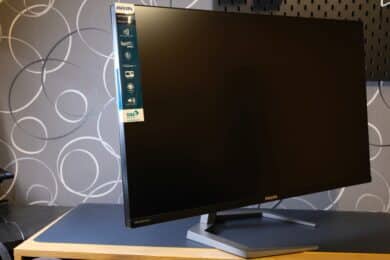

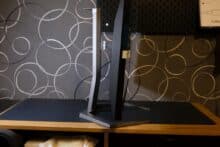
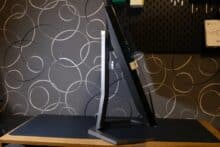







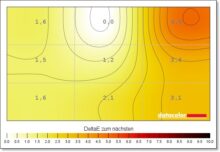
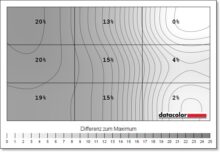
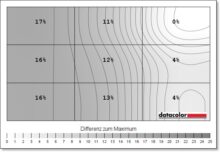

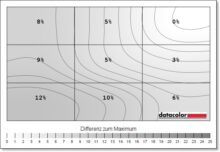

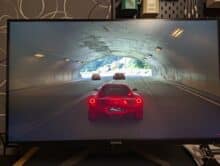

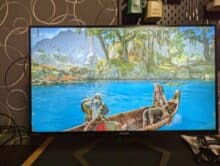




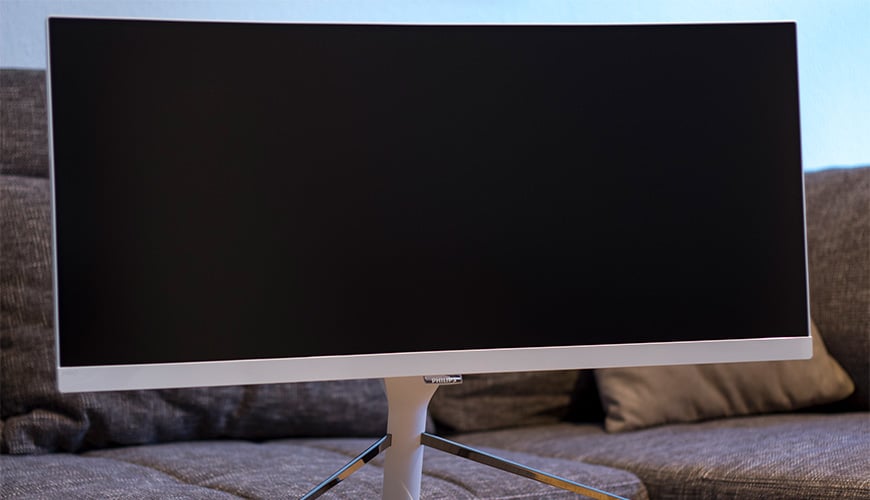


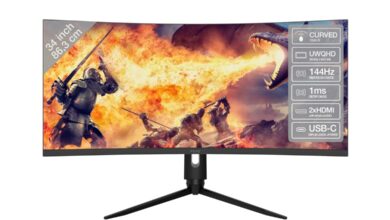
No replies yet
Neue Antworten laden...
Gehört zum Inventar
Beteilige dich an der Diskussion in der Basic Tutorials Community →